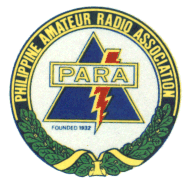
Radio Philippines Inc.
Radio Amateur Development and Information Organization of the Philippines Inc.
Regular member of the Philippine Amateur Radio Association PARA

 |
D X 1 R
P I
Radio Philippines Inc. Radio Amateur Development and Information Organization of the Philippines Inc. Regular member of the Philippine Amateur Radio Association PARA |
 |
Philippine Amateur Radio Regulations
In this page 4F1RWW provides all interested person
with some information about the Philippine
licencing system. This page should serve foreignen
HAM´s to be aware of Philippine Amateur
Radio Regulation. For comments please feal free to
address them to 4F1RWW direct.
If you see some errors or mistakes please inform me
about this, nobody is perfect.
73 de Klaus 4F1RWW
Amateur Radio Band allocation for the Phillippines
Licencing information for Foreignen HAM´s
List of National Telecommunication Commission offices in the Philippines (comming soon)
Temporary
Permit DU1/....
Foreignen HAM´s visiting
the Philippines
For amateurs holding a valid License of a country that
has a reciprocal agreement with the Philippines, it is not difficult to
obtain a temporary permit. This permit is valid for 1 year and renewable
every year. The fastest way to obtain a License is to go in person to the
local NTC (National Telecommunication Commission) and bring an application
form and a form for the permit of owning amateur radio equipment. You have
to specify the Type and Serial Number of all your Radio Equipment, since
this must be Licensed too. New is that you have to present a custom clearance
paper indicating that you have properly imported the equipment and that
you paid all taxes and duties. The Form for the owner ship of the Amateur
Radio Equipment must be notarized. This could be done by any local public
notary in the Philippines. (Remind that this is not a custom clearance,
for the custom this is a different matter.)
Furthermore please note, no permit for equipment,
no license. The best is to official use the station of a local HAM,
but you need also a permit in doing so, also the inviting HAM needs the
permit of the NTC before an other Amateur could use his station..
Note also, to transport your equipment within the Philippines
you need to have a Permit to Transfer from the NTC otherwise it
might be possible that your equipment will be confiscated by the local
authorities. Further more you need two 1*1 (2.5cm*2.5cm) pictures, a copy
of the valid national license, a letter of good moral and character, which
could be issued from the employer or the national Amateur Radio Association
you belong to and all translated into english. After all the papers are
submitted personally and complete to the responsible NTC (bring your original
for presentation only, never give them away.). It takes 4 day's here
in Manila (the NTCR has change its procedure in August 1998) to obtain
the licenses. For Metro Manila, Capital Region the responsible officer
is Mr. Baylon, if the NTCR Director is in the office it might be faster,
ask for Director Ramirez . Mostly both of them are very exited to
meet foreignen Amateurs.
To avoid confusion about the equivalent class of your
license, bring some supporting documents, describing the Amateur License
Class you are holding.
An application fee of currently 150P will be charged.
Application forms for the permits must be obtained by the responsible NTC.
There is no unique form and every NTC is producing their own application
form. At the moment Region 3 is issuing 4F3/.......(Foreignen
Call), wherein Region 1 is issuing DU1/.....(Foreignen
Call). I do not have information about the other Regions, but it seems
to become a standard to do the issuing of calls in accordance to the ITU-R
recommendations. (guest country prefix before the licensing country). The
permitted frequency bands are listed bellow.
Philippine
Call Sign
If you intend to stay longer in the Philippines and you
wish to have a local amateur call sign DU1.... You need to take the Amateur
Radio Examination. The NTC will advise you in the requirements to do so.
They have to grant you the privilege to take the examination test. This
takes on a regular base a minimum of two month, granting the privilege
to take the exam, releasing the results (after one month) and finally getting
the Call sign.
Philippine
Amateurs
If you like to met some nice OM's join one of the local
clubs, where you could meet some real nice HAM's, OM's which are
in the true spirit of amateur radio. Inquirer by PARA about the nearest
club to you QTH.
Here some QRG's frequently used
Weekend Round on 40m 7045 kHz, LSB
hourly in the morning on weekends, just login into Net Control.
Sometimes 145,400kHz FM if there are no pirates on air
(there are many in VHF).
If you arround Quezon City you are invited to join us DX1RPI.
Band
Allocation in DU
for the Amateur Radio Station of the Republic of the
Philippines
|
|
legal power CW 1 kW SSB 2 kW |
(General) legal power CW 500 W SSB 1 kW |
legal power CW 100 W SSB 200 W |
legal power 100 W |
|
|
|
|
|
|
|
|
|
|
|
|
|
|
|
|
|
|
|
secondary |
used only between 7pm and 6am *local time |
used only between 7pm and 6am *local time |
|
|
|
|
|
|
|
|
|
|
|
|
|
|
|
|
|
|
|
|
|
|
|
|
|
|
|
|
|
|
|
|
|
|
|
|
|
|
|
|
|
|
|
|
|
|
|
|
|
|